Mexican painter and self-portrait artist Frida Kahlo (1907–1954) is regarded as one of the most influential artists in 20th-century art.
She is particularly well-known for her emotional self-portraits, many of which show her physical suffering, political beliefs, and cultural background.
Despite her short lifespan and a small body of work, her paintings have had a lasting impact and continue to inspire people around the world.
Let’s see why Frida Kahlo is important? And Why has she become such a cultural icon?
- Why is Frida Kahlo Important?
- Frida Kahlo's Early Life
- Frida Kahlo’s Famous Artwork
- What's Unique in Frida Kahlo's work?
- Why is Frida Kahlo so Famous?
- Why did Frida Kahlo Paint herself?
- The Frida Kahlo Museum
- Wrapping it Up
- Conclusion
- FAQ’s
- 1. Why is Frida Kahlo considered an important artist?
- 2. What are some of Frida Kahlo's most famous artworks?
- 3. How did Frida Kahlo's personal life influence her art?
- 4. What themes are commonly found in Frida Kahlo's artwork?
- 5. How did Frida Kahlo's style evolve throughout her career?
- 6. What legacy did Frida Kahlo leave behind?
- 7. Where can I find Frida Kahlo's artwork today?
Why is Frida Kahlo Important?
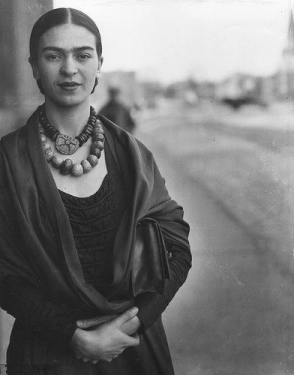
Frida Kahlo’s art is unique because it challenges traditional gender roles and depicts women from her own perspective. Her self-portraits express her emotions and personal experiences.
She was also politically active, and her work blends Mexican culture, surrealism, and realism. Her paintings are both symbolic and lifelike, reflecting her life and heritage.
Frida Kahlo's Early Life
1. How she Started Painting?
On July 6, 1907, Frida Kahlo was born in Mexico. She was raised in a bilingual and culturally diverse home as the daughter of a German father and a Mexican mothecculturally diverse home in the daughter of a German father and a Mexican mother.
Frida got polio as a young child, which caused her right leg to get weaker and gave her a lifelong limp.
She was a brilliant student despite her health issues. After a nearly tragic accident, she started painting. On September 17, 1925, a bus carrying Frida and her friend Alex collided with a street trolley car.
It took more than a year for Kahlo to recover from the bus accident, during which time she abandoned her pre-medical studies and started painting.
While her mother ordered a customized easel so that Kahlo could paint in her hospital bed, had a mirror installed in the canopy, enabling Kahlo's self-portraiture.
And her father, an artist, loaned her his oil trousers and brushes.
2. Her Married Life
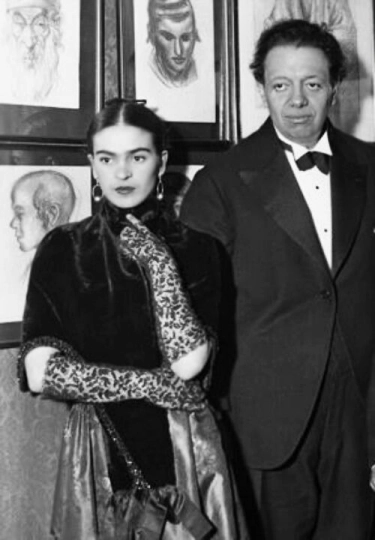
Frida and her Husband Diego Rivera [/ caption] Frida Kahlo was a Mexican artist who was married to the famous Mexican muralist Diego Rivera.
They were married twice, first in 1929 and then again in 1940 after a divorce. Despite the ups and downs in their relationship, including Rivera's numerous affairs, the two remained married until Kahlo died in 1954. Their marriage was a passionate and tumultuous one, and both Frida and Diego were known for their bohemian lifestyle and political activism.
Frida's paintings often reflected her emotional state and her relationship with Rivera was a major source of inspiration for her work.
She passed away at the age of 47, yet her legacy lives on, and she is still regarded as one of the most cherished and renowned artists of the 20th century.
Frida Kahlo’s Famous Artwork
1. Me and My Parrot
She was peaceful and relaxed as she held her four parrots while wearing traditional white clothing from Mexico. It was interesting to note that Frida and the right parrot on her shoulder had almost identical vision.
It demonstrates how close Frida was to her animal companion. Additionally, Frida finds pet companionship to be of utmost importance in stressful times.
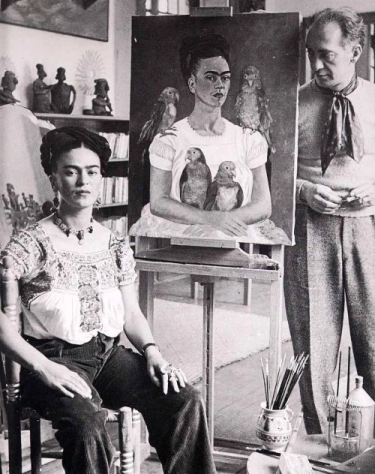
2. Self-Portrait with Bonito
Frida Kahlo captured the profound sadness she had following her father's death in this portrait. Compared to her relationship with her mum, her relationship with her dad was rather warm and close.
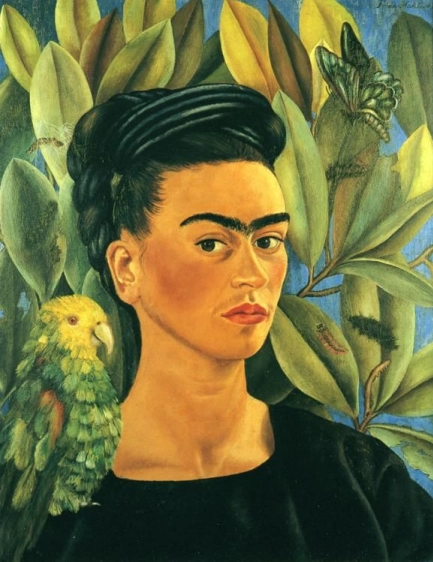
3. Self-Portrait with Thorn
Necklace and Hummingbird, 1940 “Self-Portrait with Thorn Necklace and Hummingbird” is one of the most famous paintings of Frida. She made this painting after her divorce from the artist, Diego Rivera.
An unlucky black cat is perched on her right shoulder, and a monkey—possibly one of her pets and a gift from Rivera—is perched on her left shoulder.
The blood is drawn when the monkey, who is frequently depicted as the devil, tugs at the thorn necklace around her neck. The usage of the thorn necklace in this illustration has been connected to Christ's use of the thorny crown, which symbolizes the anguish and suffering she underwent. Kahlo is portraying herself as a martyr who endures great anguish and suffering.
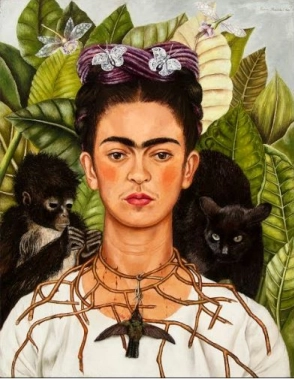
4. The Two Fridas
The painting depicts two versions of Frida, each holding the other's hand and their hearts exposed, connected by visible veins. It was painted in 1939, during a time when Frida was going through a difficult emotional period following her divorce from her husband, Diego Rivera.
The work has also been interpreted as a symbol of Frida's inner struggle and her desire to heal. "The Two Fridas" is considered a powerful expression of Frida's emotional state and a testament to her strength and resilience.
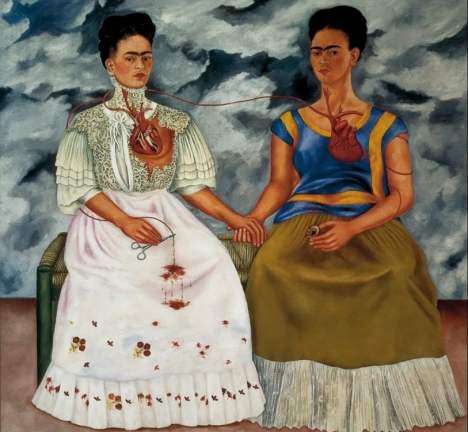
5. Self-Portrait with Monkey
“Portrait of Frida Kahlo with Monkey" is a painting by Frida Kahlo that was created in 1938. In the painting, Frida is depicted holding a pet monkey on her shoulder.
The monkey, a symbol of mischief and cunning, represents Frida's playful and mischievous side.
In this painting, Frida is depicted as confident, strong, and self-assured, with the monkey adding a sense of playfulness and lightness to the painting.
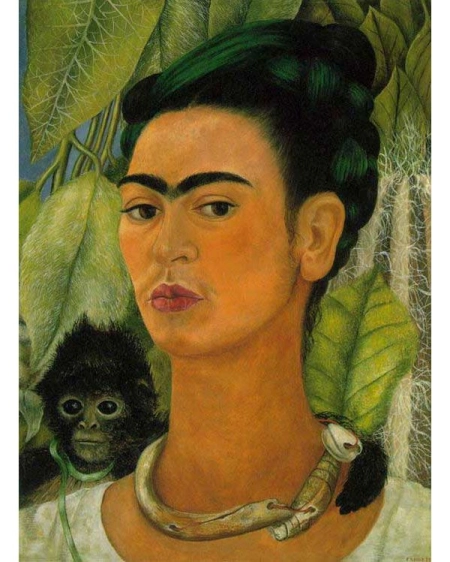
What's Unique in Frida Kahlo's work?
1. Paintings by Frida Kahlo
Paintings by Frida Kahlo are renowned for their distinctive styles and themes. Her art stands out for a variety of reasons, some of which include:
Element of surrealism
Kahlo frequently uses dreamlike images and fantastical themes in her paintings.
Self-portraits
Kahlo employed self-portraits to investigate and communicate her identity, feelings, and physical challenges. They make up a significant portion of her body of work.
Mexican cultural references
Kahlo frequently uses folk art, vivid colors, and native dress in her paintings as well as other traditional Mexican motifs and symbols.
Physical suffering and trauma
Kahlo frequently depicts her physical suffering and trauma in her artwork, notably in connection with a serious accident she had as a young lady and her numerous surgeries.
Commentary on politics and society
Kahlo's work also reflects her political and social beliefs, including her support for Communism and her criticism of colonialism and the dominant cultural norms of her time.
These unique elements have made Frida Kahlo one of the most recognizable and influential artists of the 20th century.
Why is Frida Kahlo so Famous?
Frida Kahlo is considered a legendary figure in the art world and is widely recognized as one of the most famous painters of the 20th century. There are several reasons why Frida Kahlo has achieved such widespread fame and recognition.
The paintings of Frida Kahlo are, first and foremost, incredibly powerful emotionally and aesthetically. Her artwork frequently includes self-portraits that depict her emotional and physical battles with disease, disability, and loss.
Her paintings are both deeply personal and universal in their themes, as they explore the complexities of the human experience in a way that resonates with people of all cultures and backgrounds.
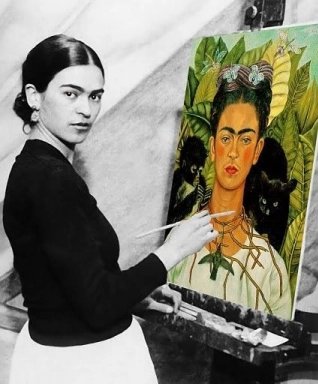
Frida while working on her famous painting Self-Portrait with Thorn Necklace and Hummingbird, 1940 In addition, Frida Kahlo has a distinctive and well-known style. She developed a fresh kind of magical realism by fusing aspects of Mexican folk art, surrealism, and realism.
Her works frequently use symbols and motifs from Mexican mythology and culture and frequently have a surreal or dreamlike quality. Her aesthetic continues to affect artists today. She had a significant impact on the Mexican muralist movement.
Due to her refusal to conform to conventional gender norms and depictions of women’s art, Frida Kahlo is also regarded as a feminist icon. Her self-portraits are quite distinctive and capture her own viewpoint, feelings, and emotions in a way that was out of the ordinary at the time.
Her works frequently question conventional gender roles, and her legacy has inspired and empowered women all around the world.
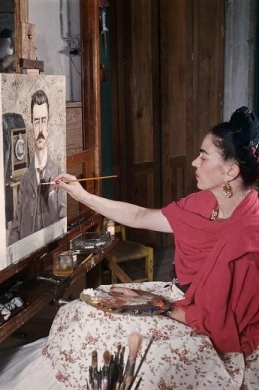
Why did Frida Kahlo Paint herself?
Given her physical restrictions as a result of her various surgeries and impairments, Frida Kahlo regularly painted herself in her self-portraits because she thought she was the easiest subject to work with.
But she also used self-portraiture as a way to investigate and communicate her identity, feelings, and experiences. She portrayed not just her outward look but also her psychological state, political views, and cultural background through her self-portraits.
Kahlo frequently paints self-portraits that are intensely intimate and contemplative and that provide a singular window into her life and indeas. She was able to investigate and make sense of her individual experiences through painting while also m asking for statements about more general political and societal themes
Overall, Frida Kahlo's self-portraits are considered some of her most powerful and iconic works, and they have become synonymous with her artistic vision and legacy.
The Frida Kahlo Museum
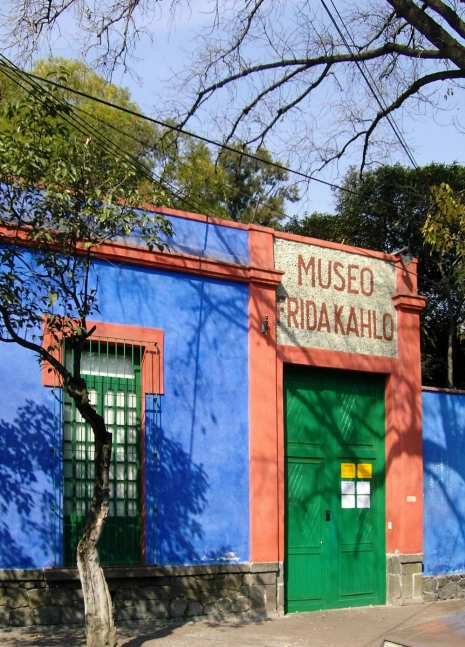
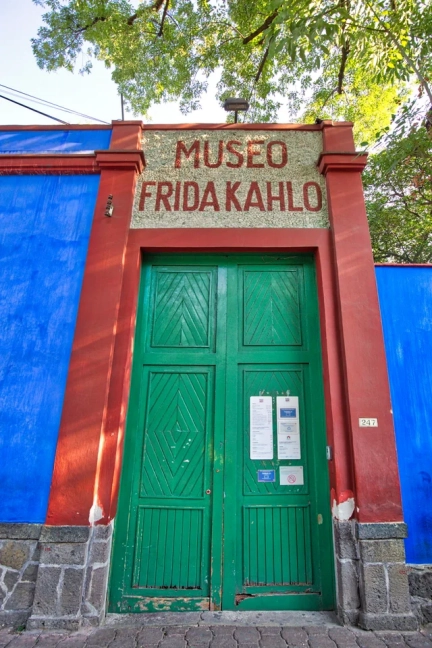
Frida Kahlo Museum, also known as the Casa Azul or the Blue House, is the birthplace and lifelong home of the famous Mexican artist. Located in Mexico City, the house was turned into a museum dedicated to Kahlo's life and work after her death in 1954.
The museum contains a vast collection of Frida Kahlo's personal belongings, including her paintings, photographs, clothing, jewelry, and other memorabilia. Visitors can also see the house and garden where Kahlo lived and worked, which have been preserved as a testament to her life and artistic legacy.
The Frida Kahlo Museum is considered one of the most important cultural institutions in Mexico, attracting thousands of visitors from around the world each year. It provides a unique opportunity to learn about the life and work of one of Mexico's most iconic and beloved artists and to gain a deeper understanding of her cultural and historical context.
Wrapping it Up
Frida Kahlo's impact on art, culture, and society is undeniable. Her unique vision and powerful voice continue to inspire and challenge generations of artists and thinkers, making her an enduring and important figure in the history of art.
Whether you are an artist, a feminist, or simply someone who appreciates the power of creativity, Frida Kahlo is a figure who deserves recognition and respect.
Conclusion
Frida Kahlo's importance in art and culture cannot be overstated. Through her life and work, she has inspired countless individuals and has left an indelible mark on the art world.
Her exploration of identity, pain, and culture continues to resonate today, making her a timeless figure in both art history and contemporary discussions around gender and identity.
FAQ’s
1. Why is Frida Kahlo considered an important artist?
Frida Kahlo is considered an important artist because she uniquely merged personal experiences with broader social and cultural themes.
Her artwork explores identity, post-colonialism, gender, class, and race in Mexican society. Kahlo's distinctive style and symbolism resonate with many, making her a feminist icon and a powerful figure in modern art.
2. What are some of Frida Kahlo's most famous artworks?
Some of Frida Kahlo's most famous artworks include:
"The Two Fridas" (1939) - Represents her dual heritage and identity.
"Self-Portrait with Thorn Necklace and Hummingbird" (1940) - Reflects her pain and struggles, showcasing her personal symbolism.
"The Broken Column" (1944) - Depicts her physical suffering after a severe bus accident, blending surrealism with raw emotion.
3. How did Frida Kahlo's personal life influence her art?
Frida Kahlo's personal life had a profound impact on her art. Her experiences with chronic pain, a tumultuous marriage to Diego Rivera, and her Mexican heritage played pivotal roles in shaping her creative expression. Kahlo often incorporated elements of her emotional and physical struggles into her work, making her art deeply personal and relatable.
4. What themes are commonly found in Frida Kahlo's artwork?
Frida Kahlo's artwork commonly explores themes such as:
Identity - Reflecting her mixed heritage and personal struggles.
Femininity - Challenges traditional gender roles and celebrates womanhood.
Pain and Suffering - Depicting her physical and emotional hardships.
Cultural Heritage - Incorporating Mexican folklore, symbolism, and culture.
5. How did Frida Kahlo's style evolve throughout her career?
Frida Kahlo's style evolved from traditional Mexican folk art to a more personal, symbolic approach. Early works show influence from European styles, but as her life experiences shaped her, her paintings became more introspective and surreal. She developed a unique blend of realism and fantasy, employing bright colors and intricate details that reflect her cultural background.
6. What legacy did Frida Kahlo leave behind?
Frida Kahlo's legacy includes her impact on feminist art, her role as a cultural icon, and her influence on later generations of artists. She opened conversations about gender, identity, and bodily autonomy, inspiring movements for women's rights and LGBTQ+ advocacy. Her life story and artwork continue to resonate, making her a symbol of resilience and creativity.
7. Where can I find Frida Kahlo's artwork today?
Frida Kahlo's artwork can be found in various museums and galleries worldwide, with a significant collection housed in the Museo Frida Kahlo in Mexico City. Many of her most famous pieces are also part of collections at the Museum of Modern Art in New York and the Harry Ransom Center in Austin, Texas. Additionally, her works are often featured in traveling exhibitions and retrospectives across the globe.


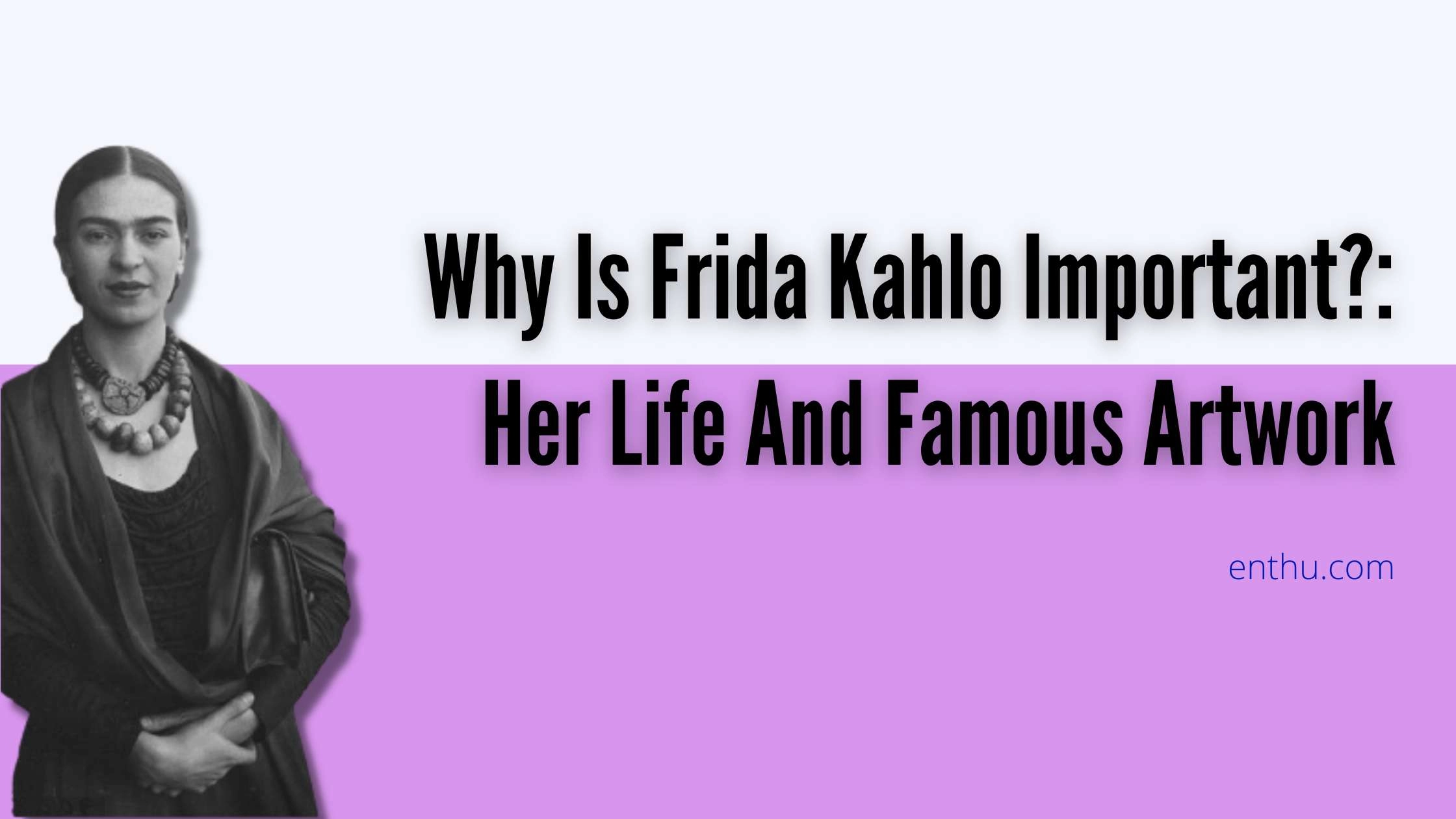
.png)


Comments